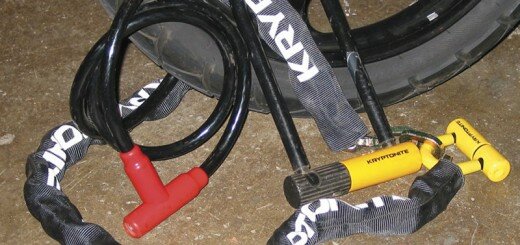Once again I heard experienced riders only partially explain to some newbies that they needed to be careful after putting new tyres on their bikes. They were told that this was because the new tyres do not have as much traction on them until they are scuffed up a little.
It is not that I dispute that fact – new tyres do provide less traction until the new-tyre coating is worn off of them. But that is not the whole story and if no more is said about them an inexperienced rider could do something very foolish and dangerous if they rely simply on that information.
They could, for example, scuff the new tyres using an abrasive just after mounting them and then take off to tackle some twisties. Lower traction would not, then, be a significant problem. But that is a far cry from saying that the new tyres would be safely usable in stress situations as a result.
ALL new tyres grow during the first 100 kilometres or so of use. It is absolutely essential that you allow them to do so before putting them to a stress test such as attempting to aggressively navigate a set of twisties.
Why? Because it is the process of growing that results in a tight and secure bead to rim seating. If you put the tyres to undue stress before their beads have seated to the wheel rims there is a possibility that you will experience a catastrophic loss of air while heeled over in a turn.
Rather than using an abrasive to convert a new tyre into a used one, better by far to ride on them for a 100 kilometres or so. Besides, it’s more fun doing it that way.
New or used, before you stress your tyres in the twisties you MUST allow them to get warm first. Traction available on a cold tyre is significantly less than for a warm one. Similarly, if you are doing a lot of twisties and your tyres get HOT, traction is diminished. Maximum traction exists only under normal operating temperatures.
Tyre Pressure
For longest tyre life it is my recommendation that you strive to keep them at the higher limit of their recommended pressures (regardless of what your motorcycle owner’s manual might say to the contrary.)
Further to this, pressure should be determined while the tyres are cold – meaning, have not been used for a couple of hours.
Outside temperatures affect your tyre pressure far more profoundly, however. As temperature goes, so does pressure.
There is nothing wrong with your tyre if it behaves like this, of course. What is being illustrated here is that you MUST check your tyre pressure on a regular basis (about once a week is reasonable) and to be particularly aware of it on cold days.
Tyre Wear
Excessive tyre wear, and/or cupping, is a problem that most motorcyclists experience over me. Too often this is simply the result of failing to maintain proper tyre pressure. However, this is far from a complete answer.
Cupping is a phenomenon that is absolutely normal!
There are at least seven causes of cupping and/or uneven wear in the front tyre other than tyre air pressure:
- Most roads are banked away from the centre. Thus, if you ride vertical, the side of your tyre closest to the centre of the road wears more.
- Your tyres ‘scuff’ when you force a speed change with them. The rear tyre scuffs when you accelerate and when you brake (and every me you ride in a direction other than straight ahead.) Thus, it tends to have even ‘cupping’ as compared to the front tyre (which scuffs when you brake but not when you accelerate.)
- While alignment is not usually a problem with motorcycles – it can be.
- Carrying an unevenly divided load (all your tools, jumper cable, etc.) in one saddlebag or pannier can result in your riding the bike other than vertical most of the me.
- If one of your front shocks is defective you will experience uneven tyre wear.
- Excessive use of the front brake will result in excessive cupping.

Safety
Tyres are the only points of contact between the motorcycle and the road. The total contact area between a motorcycle’s two tyres and the road is approximately 100cm2, so it’s essential to protect the quality and performance of your tyres.
INSPECTION: Tyres must be inspected on a routine basis for irregular wear patterns, which can be an indication of incorrect inflation pressure, overloading or mechanical problems. An underinflated or overloaded tyre that is ridden for a prolonged period may suffer irreversible damage that can have serious consequences, even if the tyre is returned to correct inflation pressure.
Tyres should be inspected regularly, with Safetyparcular attention paid to:
– The tread area, to detect the presence of debris, cuts, deterioration or irregular wear patterns;
– Sidewalls, to detect impact damage (from potholes or kerbs), cuts, cracking or abnormal deformaon;
– The bead area, noting any trace of abrasions or rim damage.
WEAR: The primary function of the tread is adhesion with the road. As tyre wear progresses over me, the tyre’s ability to evacuate water deteriorates; consequently, you should reduce speed on wet roads. Remember to check regularly for tyre wear, by observing tread depth and uniformity of the wear pattern.
A tyre’s durability is dependent on several major factors:
– Some are within the rider’s control, such as inflation pressure, loads carried, vehicle speed and riding style.
– Others are beyond the rider’s control, and require adaptation of one’s riding style: frequency of corners, type of road surface, ambient temperature.
Remember that mechanical problems can also cause premature wear, including warped rims, worn suspension components, loose steering-head bearings and/or frame misalignment. Any one of these factors can have a detrimental effect on tread life; a combination of several factors will cause significant wear.
INFLATION: Correct inflation is essential to the tyres’ safety, comfort and durability. Maintaining the bike manufacturer’s recommended inflation pressures has a positive effect on handling characteristics. It is also a major influence on the motorcycle’s handling, both in a straight line and when cornering, even at moderate speeds and under braking.
Riding on underinflated tyres can cause premature wear, irreversible damage to the casing and, possibly, a catastrophic deflation. Tyres lose air gradually. It is essential to check pressure every 2 weeks, when the tyres are cold.
If the pressure is checked during or aer a ride, the tyres will be hot, which will increase the indicated pressure. Never deflate tyres when they are hot. If the pressure reading is lower than the recommended pressure, air must be added to the tyre. Keep in mind that the indicated pressure of a hot tyre can be as much as 4psi higher than the recommended cold pressure.
RUNNING-IN: During the first 100km of operation after new tyres have been fitted, the motorcycle should be ridden at moderate speed, and cornering angles should be increased progressively, until the tyre reaches its optimal performance.
WARM-UP: During the first 10 – 20km of each ride, travel at moderate speed until the tyres achieve operating temperature and optimal grip.
MIXING TYRES: All recommendations and precautions are based on equipping the motorcycle with the same brand tyres both front and rear to prevent unstable handling.











